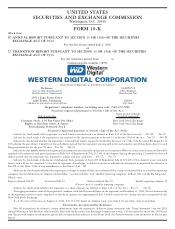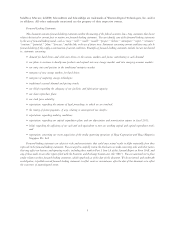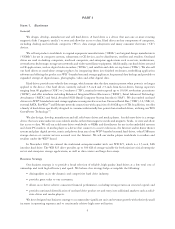Western Digital 2010 Annual Report Download - page 16
Download and view the complete annual report
Please find page 16 of the 2010 Western Digital annual report below. You can navigate through the pages in the report by either clicking on the pages listed below, or by using the keyword search tool below to find specific information within the annual report.security and protection through our patented and patent-pending PowerArmor», SiSMART», SolidStor
»
, SiSecure
TM
and
LifeEST
TM
technologies. Our WD SiliconEdge»product family consists of 2.5-inch form factors, with capacities ranging
from 64 GB to 256 GB, SATA interfaces, and read/write speeds of up to 250/170 MB per second. Our WD SiliconEdge»
products are designed for both read-intensive client and consumer applications and write-intensive OEM applications.
They also feature both multi-level cell and single-level cell semiconductor media as well as patented and patent-pending
technologies, such as advanced wear-leveling, error correction control, and industry standard performance optimization
commands such as TRIM and Native Command Queuing to ensure maximum drive performance and endurance with
easy plug and play compatibility.
Research and Development
We devote substantial resources to development of new products and improvement of existing products. We focus
our engineering efforts on coordinating our product design and manufacturing processes to bring our products to market
in a cost-effective and timely manner. Research and development expenses totaled $611 million, $509 million and
$464 million in 2010, 2009 and 2008, respectively.
Fiscal 2010 represented the ninth consecutive year of substantial growth in our research and development spending
to support the significant broadening of our product and technology portfolios. Consistently over that nine-year period,
we grew our research and development spending 441% from $113 million in fiscal 2001 to $611 million in fiscal 2010.
As a result of this investment activity, we continue to expand our business beyond the desktop PC market into newer
markets or markets in which we have not previously participated. Such investments have allowed us to execute against
our strategic objective of revenue diversification to address the growth of new applications for hard drives and fast-
growing new market opportunities.
For an additional discussion of risks related to our development of new products, see Item 1A of this Annual Report
on Form 10-K.
Technology and Product Development
Hard drives record, store and retrieve digital data. Performance attributes of hard drives, such as their ability to
access and transmit data and storage capacity, are currently better than removable disks, optical hard drives and tapes, and
they are more cost-effective than semiconductor technology. The primary measures of hard drive performance include:
• “Acoustics” — which is the sound power emitted during hard drive operation, commonly expressed in decibels,
and perceived loudness due to sound pressure, commonly expressed in sones.
• “Data transfer rate” — which is the sustained rate of data transfer to and from the disk, commonly expressed in
gigabits per second. One gigabit equals one billion bits.
• “Seek time” — which is the time needed to position the heads over a selected track on the disk surface, commonly
expressed in milliseconds.
• “Spindle rotation speed” — which is the nominal rotation speed of the disks inside the hard drive, commonly
expressed in RPM or latency. Spindle rotation speeds commonly stated as 5,400, 7,200 and 10,000 RPM are
sometimes approximations.
• “Storage capacity” — which is the amount of data that can be stored on the hard drive, commonly expressed in
GB or TB. As defined in the hard drive industry, one GB equals one billion bytes and one TB equals one trillion
bytes. A byte is a digital character, typically comprised of eight bits. A bit is a binary digit, the smallest unit of
information in a digital system.
• “Power Consumption” — which is the amount of electricity required to operate the drive, measured in watts.
All of our hard drive products employ similar technology. The main components of the hard drive are a Head-Disk-
Assembly (“HDA”) and a Printed Circuit Board Assembly (“PCBA”).
HDA: The HDA includes heads, magnetic media, head positioning mechanism (“actuator”) and spindle motor. A
rigid base and top cover contain these components in a contamination-controlled environment. One or more disks
positioned around a motor-driven spindle hub that rotates the disks comprise the disk-pack assembly. The disk is made
10
























